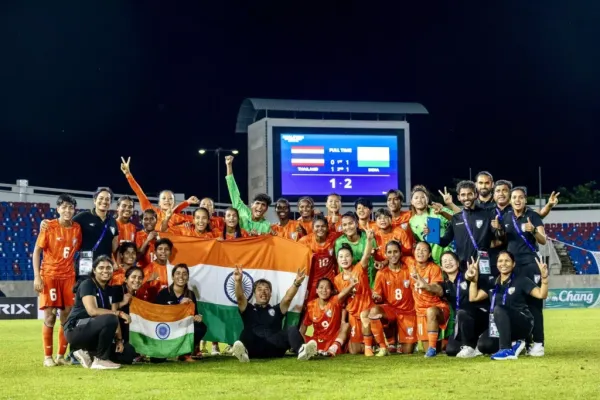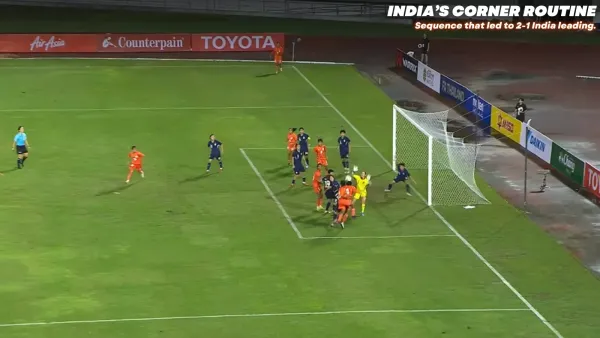

Indian football had reached a low ebb — forgotten by many, fading into silence. But amidst that despair, the Women’s National Team dared to dream. Set aside for years, they rose not just to play, but to fight for their place.
From the moment the groups were drawn, it was clear that India’s road to qualification would have to be through Thailand. And on the night that mattered, they delivered the goods. But the seeds were sown early in the group stages.
Grit and discipline
Through the group stage, India showcased their identity. Confident in possession, they played through the thirds with control, stitching together sweeping moves. Defensively, they showed grit and discipline, pressing when needed, dropping deep when required, and committing smart fouls when the moment called for it.
Their belief in the plan was clear, and the game rewarded it.
As a result, India blew past their first three opponents: pumping 13 past Mongolia, four past a resilient Timor-Leste, and five past Iraq. But it would all count for nothing without a win against Thailand, who had also kept their side of the battle alive. It all came down to the final game.
India started brightly, full of spirit and purpose, but Thailand quickly made their case. Fluid in movement and crisp in passing, they had a goal ruled out for offside just 180 seconds in. A marginal call that could have changed the game’s tone entirely; It was a warning, and to India’s credit, they responded.
India’s brand of football was bold, and it demanded courage. Possession and pressing are beautiful philosophies when they work, but dangerous when they don’t. It requires complete buy-in from the whole team. And India, for all its supposed technical limitations, bought in.
Everybody understood their roles well. There was no confusion, no hesitation; only collective belief in the plan. That clarity was their strength.
India’s 4-2-3-1 off-ball shape was disciplined, pressing high whenever the trigger came. Thailand may have expected them to sit back, but they were instead met with relentless intensity. Once the press was activated, India swarmed the ball-side, cut off options, and forced hurried decisions, leading to several turnovers and promising attacks.
India’s 4-2-3-1 off-ball shape was disciplined. (Photo credit: YouTube/ Changseuk Official)
A level playing field
Tactics, in essence, are a series of trade-offs. India’s high press left space behind, and when Thailand broke through, they looked dangerous. But India’s transitional defending was superb. Everyone but the striker dropped back quickly, closing gaps and blocking lanes. It’s not that Thailand lacked quality; they may not have anticipated the defensive resolve that met them. India did not dominate with flair; they edged it with discipline and determination.
India’s front line kept the Thai defence on edge. Anju Tamang and Pyari Xaxa were relentless with runs in behind, stretching the backline. Pyari also dropped deep to link play, offering hold-up play. On the left, Manisha Kalyan was a constant threat, beating her marker, cutting inside to shoot, or going wide to cross, making her India’s most potent outlet.
India’s style of play was perhaps best exemplified in their opening goal.
A rushed Thai buildup was cut out by centre-back Shilky Devi, the more aggressive of the Indian CB pairing. The ball was calmly progressed by her partner, the ever-composed captain, Sweety Devi. From there, pivot Sangita Basfore received the pass and shifted it wide to right-back Nirmala, who cleverly held the ball just long enough to bait Thai pressure.
That pause bought time for right-winger Rimpa and attacking midfielder Anju to move into space, creating a 2v1 against the Thai left-back. Nirmala played it to Rimpa, triggering Anju’s overlapping run. She paused, looking for support — and just as the play seemed to slow, Sangita, who had initiated the move, reappeared in the final third, collected the layoff, and fired a brilliant shot into the far corner.
Thailand had focused so much on closing passing lanes that they failed to track her late run. By the time they realised it, India had already torn their structure apart.
After the opener, India’s threat down the flanks grew, though they could not turn their dominance into a second goal. Thailand responded well, growing bolder in possession and creating more chances after conceding. At half-time, India led, but the game was still alive.
Aerial supremacy
The second half began with a jolt. Thailand equalised quickly, making the most of a lapse in India’s defensive coordination. A simple ball was slid into the six-yard area, not hit with the intent to score, but rather to confuse. Yet it rolled all the way through, untouched, and crept in at the far post. It was a goal that felt avoidable. And just like that, India’s lead had vanished.
After the equaliser, Thailand settled down. Their play was calmer and more patient. They built plays through the thirds and created clearer chances. One such sweeping move, reminiscent of India’s opener, ended with a shot that beat the keeper, but for India’s luck, it struck the post.
As Thailand took control, India’s attacks were reduced to brief transitions. Set-pieces offered some hope, but not enough to halt the Thai momentum.
With just seventeen minutes left on the clock and against the run of play, Sangita struck again, this time from a brilliant corner routine. The move had the hallmarks of a routine drill. Nirmala delivered a looping corner to the far post, where India had stacked their key aerial threats in Shilky, Manisha, and Pyari.
The delivery landed inside the six-yard box, drawing Thai goalkeeper Tiffany off her line. In the chaos that followed, with defenders expecting a direct finish, Shilky instead squared it across the goal. And there was Sangita, perfectly positioned to tap home.
Set-pieces thrive on control within chaos, and India nailed it when it mattered most.

Nirmala delivered a looping corner to the far post, where India had stacked their key aerial threats. (Photo credit: YouTube/ Changseuk Official)
With the lead in hand, India shifted into survival mode. They knew Thailand would come hard, so they focused on one thing: protecting the box.
They denied central access, broke up counters with tactical fouls, and did not hesitate to take bookings when the moment demanded it. Possession was often taken to the flanks, not just to attack, but to waste time and force risky challenges. Thailand kept pushing, but India held their nerve. Maybe it was tactical discipline. Maybe it was luck. But more than anything, it was guts.
At full-time, the celebrations told the story — India had made it. They qualified not by default, but by right.
This was a victory rooted in hard work and unshakable resolve. Indian women’s football has always been defined by resilience, and on this night, that very trait brought them through. They won the game — and the respect of fans across the country.
Now, all eyes look ahead. The World Cup dream is finally within sight.
-
Ranveer Singh's 'Dhurandhar' First Look Surpasses Ranbir Kapoor's 'Ramayana' in Views, Dominates YouTube in Just Two and a Half Minutes

-
IND vs ENG, 3rd Test, Day 1: England Win Hat-trick Of Tosses, Ben Stokes Opts To Bat First At Lord's; Check Playing XI Of Both Sides

-
Dhanush Begins Filming for New Thriller D54 with Vignesh Raja

-
31 best Amazon Prime Day deals on tried-and-tested products our shopping experts love

-
Mitti Ek Nayi Pehchaan: A Heartfelt Journey Back to Roots
